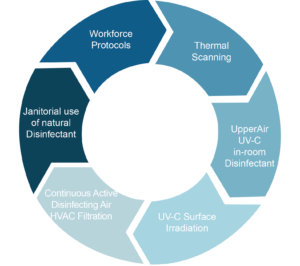Post-COVID Resilient Resistant Workplaces
COVID RESOURCES
As society and the economy move from the Stand-down phase into the phases of Re-starting, Recovering, and ultimately Thriving, how will Resilient-Resistant leaders and organizations transform themselves and their work environments? How will they ensure the safety of their employees and customers? How can they build trust and improve the workplace making it more resilient and resistant to bacteria and virus?
Thankfully, there are established technologies that have been used for decades by hospitals, bio-research laboratories, and the government that have proven to be effective at killing viruses.
The Broaddus Companies can facilitate these improvements to your workplace environment, buildings, and facilities by making them more resilient and resistant. A Resilient-Resistant Workspace (or facility) is safer and helps build trust with both employees and customers by showing their well-being remains the top priority. As a result, places of business can move from the Recover Phase to Thriving more quickly (and possibly ahead of the competition).
The Broaddus Companies have 20 years of experience consulting and working with leading hospitals, academic healthcare facilities, and biological research laboratories to build and improve safe working environments. The science of building facilities to control the spread of infectious diseases has been successfully tested and used for decades in healthcare, bio-research, and government facilities. These technologies can be leveraged to build a multi-layered defense for your workplace, resulting in a Resilient-Resistant Workplace.
We can advise your teams, bring industry Best Practices, and quickly deliver turn-key solutions to make your office and facilities resilient and resistant against biological threats now, and ready for the Re-Start and Recover Phases.
Resilient-Resistant Workplace
A Resilient-Resistant Workplace combines multiple technologies, practices, and products in a multi-layered approach. These layers are described hereafter, and include resources to remotely monitor individuals’ temperatures, sanitized air systems through UV-C Germicidal lights and Photohydriononiaztion (safe active disinfecting air), and use FDA-approved healthcare grade disinfectants and cleaners effective against COVID-type viruses, bacteria, and fungi.
Layer 1: A comprehensive, multilayered defense approach begins with you, your team, and your personnel protocols, including virtual work and occupancy policies.
Layer 2: Thermal testing and cameras to check individual temperatures.
Layer 3: Active and passive UV-C Disinfected Upper Air Systems with hydro-ionization systems.
Layer 4: Active and passive In-duct Air filtration and UV-C disinfection systems with hydro-ionization systems
Layer 5: Direct UV-C Germicidal light and disinfectant systems (mobile, handheld, and robotic).
Layer 6: New infrastructure options, including automatic doors, voice activated elevators, motion sensor sinks, sanitizer dispensers, germicidal floors, and desks.
Layer 7: Safe and effective FDA-approved natural disinfectants and cleaners.
Combine these multi-layered approaches to deliver a Resilient-Resistant Facilities Workplace solution. These approaches have been used for years in hospitals and research laboratories for infectious disease control, and can be safely, effectively and affordably applied to the corporate office place.
Our team of engineers and architects can help tailor the right layered facilities solutions for your office and work place. Resilient-Resistant facilities make employees feel more comfortable returning to a workplace environment.
Resilient Resistant Workspace Layers
Layer 1: Workforce protocols are generally centered around CDC protocols and are well documented at this point (example- if sick; stay at home, wash hands frequently, use sanitizing, social distancing, etc.). Other employer-sponsored measures could include providing all employees with masks and sanitizer.
Layer 2: Thermal Imaging Devices can read body temperatures from a distance of 6 feet or more, thus limiting the amount of personal contact needed for testing. Placed at building entrances, all employees and visitors would receive a reading as they arrive at the workspace.
Layer 3: Upper Air In-Room systems treat air in the room with UV-C light. While the clean air circulates down, infected air floats up and is killed by the UV light. These can also include active ionization systems that kill germs all over the room, and within 3 feet of a sneeze.
Layer 4: In-Duct systems use UV-C and Fresh Air to kill viruses. Per the American Society of Heating, Refrigerating and Air-Conditioning Engineers (ASHRAE), there are four primary methods of reducing airborne infectious agents in the duct systems: 1. Dilution, 2. Filtration, 3. Pressurization, and 4. Disinfection.
- Dilution of the air stream involves bringing more outside fresh air into the HVAC system.
- Filtration uses advanced highly efficient HEPA filters to capture the contaminants and includes UV-C light to disinfect HVAC coils and system air.
- Pressurization uses positive or negative pressures to contain and move primary air and makeup air around as desired.
- Disinfection involves ionization using UV energy combined with naturally occurring compounds to create disinfecting oxidized radials that kill viruses throughout the room.
Layer 5: Direct UV-C light provides surface disinfection. Ultraviolet germicidal irradiation (UVGI) is a disinfection method that uses short-wavelength ultraviolet light (UV-C), which has been used by infection control professionals for decades. CDC Guidelines recommend its use as an engineering tool to help mitigate the spread of infection.
Layer 6: New Infrastructure such as anti-microbial flooring systems and countertops, automated doors, and motion activated sinks and other items that can be installed in high use areas.
Layer 7: Natural disinfectant and cleaners that kill COVID-19 and are FDA-approved as human and food safe. Some, like the R-water system, allow owners to make their own disinfectant and cleaners safely at the office with no chemicals.
Please contact Scot Sanders, PE, CEM, Region Vice President; ssanders@broaddususa.com; The Broaddus Companies. For questions please visit www.Broaddususa.com.
To download the Post-COVID Resilient-Resistant Workplaces report, click here.

